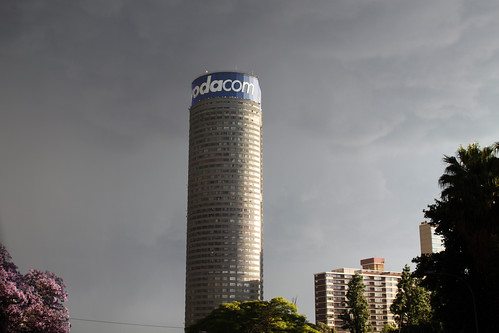Apartheid and Its Aftermath, in the Story of One Very Tall Apartment Building [VIDEO]
The 54-story Ponte Tower, designed in Brutalist architectural style as a standing cylindrical tube with a hollow center, began life in 1975 as luxury apartments for the privileged class of Johannesburg. Whites occupied the outward-facing apartments, their servants relegated to the spaces facing the inner core. If you were South African, wealthy and had aspirations, Ponte City – as it was first known – was the place to be.
In an article published in 2008 in the Christian Science Monitor, Stephanie Hanes describes the building's heyday:
"In the 1970s, Ponte was the place to live in Johannesburg, which people here called the New York City of Africa. It was on the edge of Hillbrow, a bustling, cosmopolitan neighborhood of artists and intellectuals where cafes and bookshops stayed open late and where, even under the tight rule of apartheid, interracial mixing was common.
"'Hillbrow was really the center of life,' recalls architect Rodney Grosskopff, who started designing the Ponte in 1973. After brainstorming with his colleagues, Mr. Grosskopff decided to make this new residential structure a cylinder – the first circular skyscraper in Africa, perched on a cliff-like peninsula overlooking downtown's main eastern artery . . .
"[The developers] put retail stores at the bottom and had plans to include an indoor ski slope on the core floor. They built saunas and chrome bars in all the penthouses."
The tower's ambitious beginning and prominent (if, to this observer's eyes, undistinguished) architecture, however, belie a deeply troubled history. By the 1980s, affluent whites fled the densely populated districts of central Johannesburg, as they had in American cities beginning three decades before, moving to new suburbs and taking their investment resources and tax dollars with them. Property values in the center plummeted and gangs moved in.
The process accelerated after the end of apartheid in 1994, and Ponte went downhill fast. Here's one blogger's grim description of the 1990s:
"After the fall of the Apartheid, however, things got even worse at the tower. The surrounding neighborhood, once an upscale area of Johannesburg, became consumed by crime and drug-dealing gangs began moving into the building. Ponte City eventually became a hub for criminal activity. Dangerous and uninhabitable, management and homeowners abandoned the building and left it to decay. Garbage piled up in the courtyard of the building up to five stories high. In the late 90s, it was suggested that the structure be turned into a maximum security prison, but this idea was later discarded. At its lowest point, Ponte Tower was single-handedly raising suicide rates in the city and became known as 'suicide central'."
Things apparently settled down a bit after 2000, and the building began to attract investment again. The London-based Kempston Group, which owned the building, began refurbishment, at least to a modest standard, if not to the originally intended opulence. The company hired Elma and Danie Celliers, a husband and wife team, to manage the property.
What they found wasn't pretty. Danie Celliers is quoted in a 2012 story by Nickolaus Bauer in the Mail & Guardian:
"Jeez, it was bad. Nothing was working. In one flat I found a tomato plant growing out of the sink. It filled up the whole kitchen. It was a tree, that thing. Big tomatoes on it, too."
Nonetheless, the work was done and Kempston had achieved 97 percent occupancy in Ponte Tower by the mid-2000s.
But new investor/developers David Selvan and Noor Addine Ayyoub came onto the scene in 2007 with bigger plans to once again remake Ponte into a luxury building. Their company evicted Kempston's tenants and began stripping the building in anticipation of taking complete ownership of the property. The real estate market soon crashed, however; anticipated bank loans never materialized; and the new investors were forced to pull out, leaving debt and a largely barren building behind.
Ownership then reverted to Kempston, which found itself holding what was essentially a 54-story modern ruin, with a sketchy-at-best notoriety and virtually no tenants.
Bauer's article picks up the story:
"So the opulent transformation was left unfinished, Ponte was left in tatters, the tallest residential building in the southern hemisphere was stripped from head to toe and its infamous core filled up to the fifth floor with building rubble and general refuse.
"Of the 467 flats in the building, just more than 40 were occupied when reconstruction finally ceased. Kempston took back the building in 2009, beginning its own refurbishment in the Selvan and Ayyoub aftermath, a process which lasted a little more than two years."
Kempston had to reconstruct everything yet again, from the infrastructure inside right up to the building's shady reputation, according to a company official quoted in Bauer's article.
Today, however, the building is reportedly occupied again and reigns over its part of Johannesburg's skyline, no longer in luxury, but no longer in apocalyptic chaos, either. It is, rather, mixed-income, mixed-race (to a degree), and relatively safe.
When I came across Ponte Tower's story, I couldn't help but see it as a kind of metaphor for South African society, beginning as a showy palace of sorts for a racist ruling class, then descending into violence and destruction, only to emerge after fits and starts as something substantially more modest but also calmer and perhaps more sustainable.
I highly, highly recommend the very well-produced, poignant and compelling video below. At ten minutes, it isn't short by internet standards, but it tells the story of the building's ups and downs more vividly and completely than my words alone can. Filmmaker Philip Bloom presents the narrative mostly through the words of the people, white and black, who live there:




